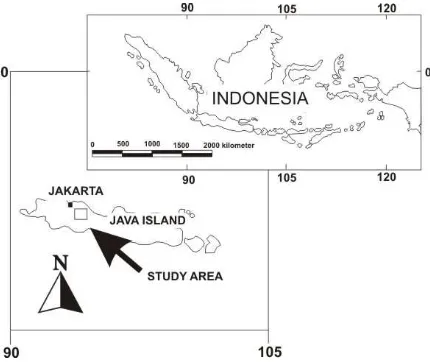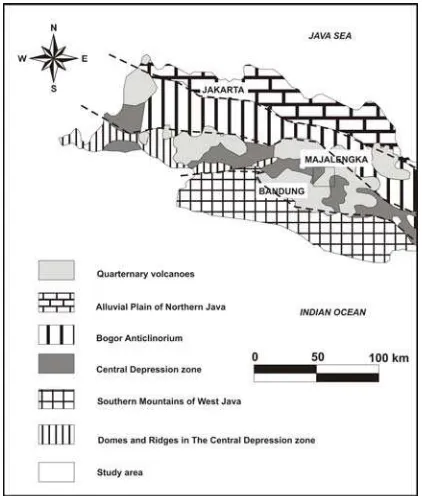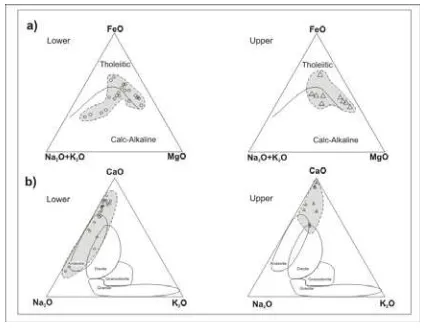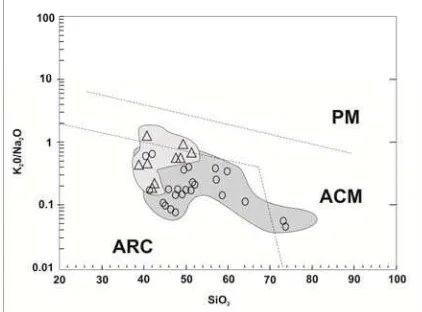1
Sandstone composition of the turbidite series
of the middle to late Miocene of Majalengka sub-basin,
West Java, Indonesia.
Budi Muljana1,2, Koichiro Watanabe1,Mega F. Rosana3 Graduate school Engineering, Khyusu University, Japan1.
Laboratory of Stratigraphy, Faculty of Geology, Padjadjaran University, Indonesia2 Laboratory of Petrology and Mineralogy, Faculty of Geology, Padjadjaran University, Indonesia3
Abstract
The sandstone of turbidite series of Majalengka sub-basin varies in geochemical composition. This series, based on biostratigraphy evidence, can be divided into two portions; lower and upper parts. This study was conducted to determine the relationships between sandstone composition and tectonic setting. The SiO2 and Na2O contents are enriched in compare to another major element (e.g TiO2, Al2O3, FeO, MnO, MgO, CaO, K2O and P2O5). Low content of Na2O value is related with relatively small amount of Na-rich plagioclase, whereas the SiO2 value shows correlation with the increasing of immaturity of grains. The SiO2 content in this study related with the quantity of quartz in the rock samples. Results of analysis indicates that most of samples are belongs to quartz-poor greywacke that quartz contents between 11-17% and K2O/Na2O ratio below 1. The AFM diagram indicates the sandstone from lower part series were distributed in calc-alkaline to tholeiitic type, whereas in the upper part series were concentrated in calc-alkaline basalt to tholeiitic type. The CaO-Na2O-K2O ternary diagram confirms that both the lower and upper part series lie upon andesite to dacite fields. Based on TiO2-Ni diagram the provenance is originated from magmatic arc and sedimentary sources. Those rocks are belongs to greywacke to lithic arenite type. The lower part sandstone populations fall upon ARC/ ACM, while the upper part is fit in to ARC and ACM. These indicated that sedimentation process in Majalengka sub-basin during Middle to Late Miocene is affected by active tectonic which is related with subduction in the southern of West Java.
Keywords : turbidites series, greywacke, andecite to dacite, Majalengka sub-basin.
INTRODUCTION
Sandstone composition is influenced by some factors such as tectonism, climate, and the origin of host rocks. The linkages between the sandstone composition and tectonism has been conducted by many authors (e.g. Dickinson and Suczek, 1979; Ingersoll and Suczek, 1979; Dickinson, 1985; Bhatia, 1983; Roser and Korch, 1986), particularly a relationship between provenance, petrography and geochemical composition. Provenance analysis based on sedimentary rocks data could be reconstructed pre-depositional history related with basin analysis. Geochemical analyses are useful to determine tectonic setting and it’s associated with provenance.
The turbidite series in Majalengka sub-basin consist of sandstone intercalation with shale. These series is deposited at deep marine environment during the middle to late Miocene. During this time, the deformation complex and high volcanic influx are two main geology events in West Java. Those events influences to depositional process of sedimentary rock in this basin.
The sedimentary rock units, lithostratigraphically, can be divided into three formations, from bottom to top, i.e. Cisaar, Cinambo and Cantayan Formations, The latter formation consist of two members i.e. Halang and Bantarujeg. According to volcanic fragments
contents that the turbidities series are divided into two portions i.e. lower part consist of Cisaar and Cinambo Formations and upper part consists of Cantayan Formation.
Fig. 1 Study area located at Majalengka, West Java Indonesia
2 Fig. 2 Physiographic of West Java according to van
Bemmelen classification (1949).
GEOLOGICAL FRAMEWORK
During Tertiary, West Java was situated at the active margin zone as a result plate motion of Indo-Australia oceanic plate beneath the southern margin of Eurasian plate (Katili, 1975; Hamilton, 1979). The plate motion was characterized by a normal subduction in which over time slowed until the last Tertiary. It was as representation of a simple model for island-arc in western Indonesia and usually indicated by some geological provinces (Hamilton, 1979). Crossing section from south to north indicated that the geological provinces consisted of accretionary prisms, subduction zone, fore-arc basin, magmatic-arc, intra-arc basin, and back-arc or foreland basin.
Van Bemmelen (1949) divided the West Java into four physiography units: (1) the Coastal Plain of Jakarta; (2) the Bogor zone; (3) the Bandung zone; and (4) the Southern Mountain. This zonation was useful to reflect both the regional structures of the region and the regional stratigraphy (fig.2).
The Coastal Plain of Jakarta which Patmosukismo and Yahya (1974) suggested as onshore part of Northwest Java basin extends from west to east. On the onshore part, the tertiary sedimentary strata forms gently folded and are covered by alluvial river deposits and lahar from Quartenary volcanoes. One of the most important of prolific zone in this region is Jatibarang fields located at northern part of study area.
Towards the south, the Bandung and Bogor zone are situated in the interior of West Java. The Bandung
zone represents the shelf edge whereas the Bogor zone represents the deepest part, and furthermore, it was called as Bogor trough (Martodjojo, 1984). In the Bandung zone, the Tertiary sediment strata are mostly covered by quaternary volcaniclastic, alluvial, and lake deposits. Extending to west, the Bayah Mountains is regarded as part of the Bandung zone.
The Bogor trough was filled by tertiary turbidite series in which tightly folded and thrusted northward onto the shelf sediments (e.g Martodjojo, 1984; Koesoemadinata and Martodjojo, 1974). Furthermore, Martodjojo (1984) has been concluded that all of sedimentary rocks in Bogor trough were derived from the south and deposited in deep marine environment. The high terrains as a sediment source in southern part of West Java are the Southern Mountain, a remnant volcanic chain as manifestation subduction in early Tertiary. This mountain is dominated by andesitic volcanic rock.
The magmatic activities during this time were no occurred continuously and occasionally took place the decreasing activity. The paucity of magmatic activity was indicated by the growing of carbonates reef, which developed in the local of paleohigh (Koesoemadinata and Martodjojo, 1974).
METHODOLOGY
X-ray fluorescence (XRF) analysis of the major and trace element geochemistry of thirty-four samples was conducted at Economic Geology laboratory, Kyushu University, Japan. Bulk chemical composition of sedimentary rock were analyzed using a Rigaku RIX 3100 X-ray (50 kv 80 mA) Fluorescence (XRF) machine. Pressed-powder pellets, which 10 mm diameter to determine of sediment composition, were prepared. Loss on ignition (LOI) was determined by evaporating the H2O content at 105oC for 1.5 hours and then followed by heating to reach 500oC during half hours and 950oC for 1 hour. The LOI value, the percentage loss in sample weight less the H2O less, was calculated. Rock type determination (Petijhon et.al., 1972; Floyd, 1989), the volcanic-rocks source (FeO-Na2O+K2O-MgO and CaO-Na2O-K2O diagrams) and tectonic setting (discriminant function) were used in determination of major and trace elements. Thirty-four samples was collected and divided into two stratigraphic intervals, lower and upper parts. The stratigraphic intervals were separated base on biostratigraphy data and results of geochemical analysis were summarized within table 1.
RESULTS AND DISCUSSION
3 restoration of TiO2, MnO, CaO, K2O and P2O5. Even though several major elements as indicator for mafic rocks underwent the decreasing value, however, was the lesser than felsic rock. Therefore, the rock composition relatively tended to become mafic rock as the source from volcanic-origin. To determine of mafic rock type was used AFM diagram (Na2O+K2O/FeO/MgO), whereas in order to felsic rock type was used triangular diagram Na2O-CaO-K2O after Le Maitre (1976) (fig. 3).
Fig. 3 a). AFM diagrams (above) and b). CaO-Na2O-K2O diagram after Le. Le Maitre (1976)
On the AFM diagram (Na2O+K2O/FeO/MgO) most of the sample populations were belongs to tholeiitic calc-alkaline series, a mixing composition of volcanic-origin source. A Slight variation is occurred on calc-alkaline series, dacite-andesite to basalt-andesite changed becomes basalt-andesite (fig.3a). These volcanic series, which form as fragment in sedimentary rocks, derived from magmatic arc zone. This zone related with subduction process of Indo-Australia oceanic plate beneath of the southern part of Eurasian plate. During the early Tertiary, the magmatic arc is located at the southern part and forms a magmatic terrain parallel with Java islands, which is usually called as the Southern Mountain (van Bemmelen, 1949).
The CaO-Na2O-K2O ternary diagram the sample population plotted on dacite to andesite fields (fig 3b). Most of them were situated close to Na2O-CaO line, or very poor K2O content. The absence of K2O was more due to post-depositional process, even though is not as primary process (Pettijhon, 1972). On the other side, the Na2O/CaO ratio shown the decreasing value and suggested that the decreasing of Na2O value reflected the growth abundance of illite, whereas the increasing CaO content tended to transform intermediate-plagioclase into carbonate cement rather than carbonate detritus occurred as albitization process.
Pettijhon (1972) proposed petrofacies classification by using log (SiO2/Al2O3) to log (Na2O/K2O) ratio (fig.4a). In this diagram, there were six petrofacies type identified (e.g. greywacke, litharenite, arkose, subarkose, sublitharenite, and quatzarenite). The samples population plotted exclusively in the greywacke field, but a little shifted towards to litharenite in upper part. Sandstone greywacke was composed by mixture of quartz, feldspar and lithic fragment bounded by matrix approximately clay to silt-size and consisted of more or less over 15%. Matrix in the sandstone greywacke could play a role as a transport media. Hence, this sandstone type was good guides for provenance and tectonic setting
discrimination compared as climate indicator.
Fig. 4 a). Log (Na2O/K2O)/Log (SiO2/Al2O3) Pettijhon,
(1972) and b).TiO2 – Ni diagrams, Floyd et.al
(1989) of sediment turbidite in Majalengka sub-basin
Meanwhile, lithareneite was abbreviation of lithic arenite as a sandstone type dominated by lithic fragment and very low of matrix. This was an indicator for local provenance and short distance transportation. The fragment was normally derived from uplifted and unroffing of some part of sedimentary basin. Geochemically, this sandstone was characterized by high Al2O3 but low of Na2O and MgO value. Therefore, both of the sandstone type could be classified as immature sandstone, deposited through turbidite process in marine environment.
4 TiO2 vs Ni diagram (Floyd et.al., 1989) indicate that the all samples from lower to upper mostly located at the same area (fig. 4b). Acid volcanic fragment and some sedimentary rocks such as sandstone and mudstone is a common lithic fragment in this sediment.
To determine tectonic setting based on greywacke composition has proposed by Crook (1974). Average of SiO2 and K2O/Na2O ratio was used as parameters for classification. Furthermore, the classification was divided into three categories (1) quartz-poor greywacke (average 58% SiO2, K2O/Na2O <<1) as indicative of magmatic island arcs and that of tholeiitic-calc alkaline (2) quartz-intermediate greywacke (average 68-74%, K2O/Na2O <1) as indicators of Andean type continental margin (3) quartz-rich greywacke indicated Atlantic-type continental margin. In this classification SiO2 represents the quarzt content and the sample population is belongs to quartz-po or greywacke with composition about 67-55.5 % and K2O/Na2O ratio below 1 or including first category Magmatic island arc. The magmatic arc provenance was considered
responsible for sediment origin with was dominantly composed by dacite to andesite.
Fig. 5 Plotting samples of discriminant scores along function I and function II. The cycle is lower part samples, while triangular for upper part samples. Show of them no indication the samples fall in the passive margin sources.
A distinctive mineralogical and geochemical signature in sedimentary rocks reflected tectonic process in plate tectonic sets. Based on the plate tectonic concept, sedimentary basin could be determined. Several workers (e.g. Bhatia, 1983; Roser and Korch, 1986) have used the geochemical of sandstone composition to determine the tectonic setting related with sedimentary basin. Bhatia (1983) has divided the tectonic setting into four types based on maturation level of island arc which was oceanic island arc (ARC), continental island arc, active continental margin (ACM) and passive margin (PM).
Plotting sample on discriminant function (Bhatia, 1983) indicated that the sample population in lower
part was situated on ARC-continental island arc- ACM, whereas the sample population in upper part fallen in only two types i.e. ARC and ACM (fig.5). The absence of origin samples from ACM in this interval indicated that re-activation of oceanic influence occurred.
On the other side, Roser and Korch (1986) separated the tectonic setting based on K2O/Na2O-SiO2 ratio in three type’s i.e. oceanic island arc (ARC), active continental margin (ACM) and passive margin (PM).Plotting data on K2O/Na2O-SiO2 ratio (Roser and Korch, 1986), in both intervals, were lies on oceanic island arc (ARC) and active continental margin (ACM) (fig.6). The increasing of K2O/Na2O ratio followed decreasing of SiO2 value on the upper part indicated that the tectonic setting led to younger stages. The most important, both of diagrams, demonstrated that there were no indication the sediment source from
passive margin or stable area.
Fig. 6 Tectonic discriminant diagram for samples from Majalengka sub-basin (after Roser and Korsch,1986). The cycle is lower part samples, while the triangular is upper samples.
CONCLUSION
The most sediment turbidite in Majalengka sub-basin belong to greywacke to lithic-arenite (Pettijhon et.al., 1972). These sediments were deposited in back-arc basin during the middle to late Miocene (Martodjojo, 1984). Provenance study indicated that the sediment sources were derived from multiple-terrain, such as magmatic-arc, recycled orogen and plutonic region (Muljana, 2006). No indication the source sediment obtained from passive margin and the magmatic arc terrain was as dominant source. The mixing of sediment source in same strata sediment indicated that during sedimentation process the tectonism accompanied by magmatism was occurred. Both of them have role important for source sediment.
5 several Tertiary volcanic rock samples in Java, Soeria-Atmadja et.al., (1994) concluded that the magmatism-break in Java during 18 to 12 Ma occurred, which accompanied by tectonism. The magmatism-break is considered as a quiet periods in Java. Andesite and dacite volcanic types are the main fragment in sedimentary rock as a lithic fragment. Those fragments are derived from the Southern
Mountain as magmatic arc in West Java, which was formed at the Oligo-Miocene subduction. Martodjojo (1984) mentioned that beside the magmatism in West Java, thrust-fault belt, which moves toward northwest from southwest, is the other important event in West Java. During the break magmatism, this fault is also diminished.
TABLE 1.
RESULTS OF ANALYSIS GEOCHEMICAL OF SEDIMENTARY ROCKS IN MAJALENGKA AREA, WEST JAVA INDONESIA.
No Interval ID SiO2 TiO2 Al2O3 FeO MnO MgO CaO Na2O K2O P2O5 H2O
1 Upper BTR-47 40.8 1.03 11.36 9.72 0.33 10.46 15.49 0.96 0.44 0.17 8.91
2 Upper BTR-61 40.74 0.52 5.46 3.24 0.3 1.77 34.53 0.57 0.75 0.07 11.74
3 Upper BTR-10 42.2 3.53 19.86 10.48 0.56 3.13 7.75 1.9 0.38 0.21 9.74
4 Upper BTR-31 38.71 0.95 11.09 7.85 0.41 9.31 18.33 0.98 0.45 0.18 11.32
5 Upper BTR-33 38.71 0.95 11.09 7.85 0.41 9.31 18.33 0.98 0.45 0.18 11.32
6 Upper BTR-17 47.84 1 16.12 8.2 0.18 6.58 7.53 3.21 1.94 0.17 6.95
7 Upper BTR-26 48.72 1.02 16.61 8 0.13 5.1 5.79 2.25 1.35 0.19 10.47
8 Upper CNB-57 49.41 0.81 16.79 5.05 0.14 2.24 7.74 1.5 1.48 0.11 14.57
9 Upper CNB-32 42.35 1.08 13.3 10.36 0.17 14.91 4.8 1.49 0.31 0.11 10.9
10 Upper CNB-48 51.42 0.79 17.82 5.28 0.15 2.83 10.7 1.7 1.19 0.13 7.65
11 Upper CNB-6 52.57 1.02 14.79 9.34 0.12 10.29 5.27 1.7 0.31 0.1 4.33
12 Upper CNB-9 44.77 1.31 15.5 10.27 0.23 9.69 9.4 1.97 0.19 0.26 6.19
13 Lower CNB-8 57.36 1 13.73 8.74 0.19 4.5 5.99 2.25 0.53 0.18 5.41
14 Lower CSR-57 42.06 0.8 13.45 3.9 0.09 2.86 17.75 2.69 1.56 0.05 14.52
15 Lower CSR-9 48.25 1.07 15.26 8.91 0.15 5.92 10.08 1.98 0.32 0.13 7.67
16 Lower CSR-40 50.93 1.14 15.72 9.54 0.09 9.24 6.8 1.49 0.54 0.13 4
17 Lower CSR-13 41.45 1.33 15.64 9.64 0.39 4.72 14.44 2.18 0.34 0.17 9.47
18 Lower CSR-11 45.16 0.89 16.18 7.3 0.29 6.71 11.47 2.83 0.24 0.18 8.62
19 Lower CSR-3 47.79 1.45 20.52 11.19 0.44 3.19 4.36 3.1 0.21 0.14 7.11
20 Lower CSR-7.3 64.41 0.85 14.81 5.16 0.08 2.57 4.37 3.15 0.32 0.13 3.85
21 Lower CLT-12 58.89 0.82 16.31 5.93 0.22 3.45 5.16 2.72 0.34 0.21 5.79
22 Lower CSR-6 46.12 0.9 19.32 9.43 0.74 2.66 7.25 2.98 0.48 0.1 9.5
23 Lower CSR-7 49.69 1 15.44 6.83 0.32 3.76 11 2.24 0.74 0.11 8.65
24 Lower CSR-8 47.8 0.99 17.98 8.84 0.11 5.32 8.9 2.47 0.33 0.21 6.04
25 Lower CLT-10 60.13 0.79 17.55 6.29 0.18 3.84 3.94 2.93 0.93 0.24 3.55
26 Lower CLT-5 46.54 1.05 15.21 8.37 0.15 10.59 8.94 2.12 0.16 0.12 6.57
27 Lower CLT-2 73.79 0.61 12.38 2.76 0.03 1.26 1.45 5.12 0.21 0.06 2.1
28 Lower CLT-7 51.83 1.03 17.44 10.48 0.27 5.34 10.76 2.03 0.41 0.24 0.01
29 Lower CLT-4 57.36 0.85 17.94 7.87 0.07 4.96 2.64 2.89 0.99 0.06 4.16
30 Lower CLT-3 50.36 1.08 15.58 9.42 0.11 8.92 7.24 1.91 0.3 0.27 4.63
31 Lower CLT-6 51.56 1.08 14.96 10.14 0.13 10.18 5.22 1.86 0.28 0.11 4.32
32 Lower CLT-1 40.61 0.65 12.55 3.2 0.08 2.31 15.51 2.71 1.49 0.05 20.62
33 Lower CNB-3 49.49 1.16 15.48 10.1 0.12 8.87 6.9 2.03 0.27 0.26 5.15
6 Furthermore, during this period, especially in Majalengka sub-basin, the isostatic accompanied by a subsidence was taken place. It related with sea level rise, transgressive, which shown by sea level curve from Haq et.al., (1987). The transgressive crest was occurred during the middle Miocene and then transformed to regressive in the late Miocene.
Related with sedimentation process, the most sediment in this basin was dominated by sediment turbidite, which the sediment source from north and south of the basin. The north sediment was from Northwest Java basin while the south was derived from the Southern Mountain (Muljana, 2006). That is supported by geochemical data from all samples indicated that that has been taken place renewals magmatism followed with uplifting (Kumon, 1994; Muljana, 2006).
Getting into the late Miocene or Pliocene in West Java, the re-activation magmatism and tectonism occurred. High volcanic fragment formed the Halang and Bantarujeg Formations, which accompanied by reverse tectonic of Baribis fault in the northern part of Majalengka area. All geological events in West Java during the middle to late Miocene correspond with the plate motion-subduction- of Indo-Australia oceanic plate beneath southern part of the Eurasia continental plate.
ACKNOWLEDGEMENTS
I would like to thank The Ministry of National Education of the Republic Indonesia for my scholarships, and Global-Centre of Excellence (G-COE) in Novel Carbon Resource Science, Kyushu University, Japan for fieldworks fund supported. And also I would like to greatly thank Dr. Darjie Noeradi from The Bandung Institute of Technology (ITB) for discussion and suggestion to completely the manuscripts.
REFERENCES
Bhatia M R, Plate tectonics and geochemical composition of sandstones. J. Geol, 91. pp. 611-627 (1983).
Dickinson W R, 1985. Interpreting detrital modes of greywacke and arkose. J. Sediment. Petrol. 40. pp. 695-707 (1985).
Dickinson W R and Suczek CA, Plate tectonics and sandstone compositions: Am.Assoc.Petrol.Geol.Bull, 63, pp.2-31 (1979).
Floyd J A, Winchester and R G Park, Geochemistry and tectonic setting of Lewisian clastic metasediments
from the Early Proterozoic Loch Maree Group of Gairloch, N.W. Scotland. Precambrian Res., 45 pp. 203–214 (1989).
Hamilton W, Tectonics of the Indonesian Region. Geol. Survey Prof.Paper 1078, U.S. Gov.Printing Office, Washington, (1979).
Ingersoll R V and Suczek C A, Petrology and Provenance of Neogen sand from Nicobar and Bengal fans, DSDP sites 211 and 218. J. Sediment. Petrol. 49, pp. 1217-1228 (1979).
Katili J A, Volcanism and plate tectonics in the Indonesian Island arcs. Tectonophysics 26, pp.165-188 (1975).
Koesoemadinata RP and Martodjojo S, Penelitian Turbidit di Pulau Jawa, Laporan Penelitian, 1295/74, pp.12-24 (1974).
Le Maitre R W, The Chemical variability of some Common Igneous Rocks. J. of Petrol. 17(4), pp.589-598 (1976).
Martodjojo S, Evolusi Cekungan Bogor, Jawa Barat, Desertasi Doktor, ITB (1984).
Patmosukismo S and Yahya I, The basement configuration of the Northwest Java area. Proc. Ann.Conv. Indon. Petrol.Assoc., 3rd, pp. 129-152, (1974).
Pettijhon F J, P E Potter, and R Siever, Sand and sandstone. Springer-verlag. New York. 618 pp. (1972). Roser B P, and Korsch R J, Determination of tectonic setting of sandstone-mudstone suites using SiO2 content and K2O/Na2O ratio, J. Geol. 94, pp. 635-650
(1986).
Soeria-Atmatja R, Maury R C, Bellon H, Pringgoprawiro H, Polvé M, Priadi B, Tertiary Magmatic belts in Java, Jour. Of Southeast Asian Earth Sciences, 9(½) pp.3-27 (1994).
Van Bemmelen van RW, The Geology of Indonesia, 1A. Martinus Nijhoff , The Heague, Netherland (1949).
Crook KAW, Lithogenesis and geotectonics: the significance of compositional variation in flysch arenits (greywackes). Soc. Econ. Paleontol. Mineral. Spec. Pub. 19 pp.304-310 (1974).
Haq BU, Hardenbol J, Vail PR, Chronology of fluctuating sea level since the Triassic. Science. 235 pp. 1156-1167 (1987).
Kumon F and K Kiminami, Modal and chemical compositions of the representative sandstone from Japanese Islands and their tectonic implications. In: Sandstone Petrology in relation to tectonic (edits.) F. Kumon and K.M.Yu. Proceedings of the 29th International Congress part. A. VSP BV The Netherlands.pp. 135-151 (1994).




